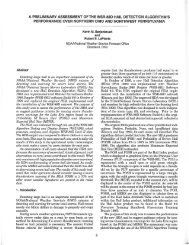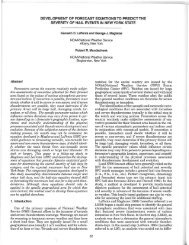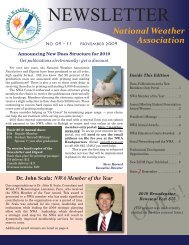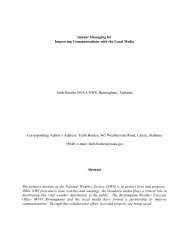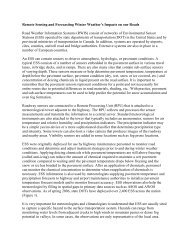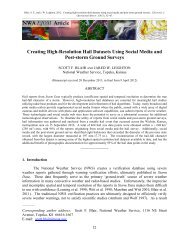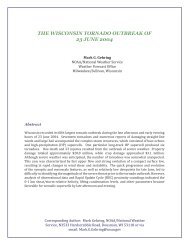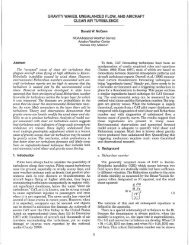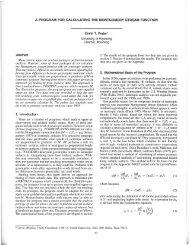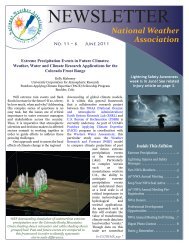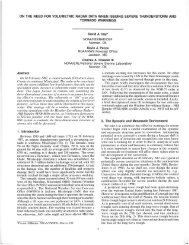ESTIMATING THE RADIUS OF MAXIMUM WINDS VIA SATELLITE ...
ESTIMATING THE RADIUS OF MAXIMUM WINDS VIA SATELLITE ...
ESTIMATING THE RADIUS OF MAXIMUM WINDS VIA SATELLITE ...
You also want an ePaper? Increase the reach of your titles
YUMPU automatically turns print PDFs into web optimized ePapers that Google loves.
<strong>ESTIMATING</strong> <strong>THE</strong> <strong>RADIUS</strong> <strong>OF</strong> <strong>MAXIMUM</strong> <strong>WINDS</strong> <strong>VIA</strong> <strong>SATELLITE</strong> DURING<br />
HURRICANE LILI (2002) OVER <strong>THE</strong> GULF <strong>OF</strong> MEXICO<br />
S. A. Hsu<br />
Coastal Studies Institute<br />
Louisiana State University<br />
Baton Rouge, Louisiana 70803<br />
Adele Babin<br />
Naval Oceanographic Office<br />
1002 Balch Boulevard<br />
Code N213<br />
Stennis Space Center, Mississippi 39522<br />
February 2005<br />
Abstract<br />
Using a single case from Hurricane Lili (2002), a technique is described to estimate the radius of<br />
tropical cyclone maximum winds (R) utilizing satellite data. For the satellite estimation of R, the<br />
distance between the coldest cloud-top temperature surrounding the eye and the warmest<br />
temperature in the eye of the hurricane measured 29 km. National Data Buoy Center (NDBC)<br />
wind speed measurements at 10 m height yielded a distance of 28.5 km when substituted into an<br />
empirical equation of the radial variation of tangential wind speed in a hurricane with the typical<br />
exponent of 0.7 for higher altitude. Both determinations of R were in excellent agreement, thus<br />
providing confidence that the satellite method may offer a reliable way to estimate R in some<br />
cases.<br />
1. Introduction<br />
According to Holton (1992), the kinetic energy of hurricanes is maintained in the presence of<br />
boundary layer dissipation by conversion of latent heat energy acquired from the underlying<br />
ocean. This potential energy conversion is carried out by a transverse secondary circulation<br />
associated with the hurricane. This circulation consists of boundary layer inflow into a region of<br />
enhanced convection surrounding the storm center that is referred to as the eyewall, ascent<br />
within convective cloud towers that tend to be concentrated in the narrow outward-sloping<br />
eyewall, radial outflow in a thin layer near the tropopause, and gentle subsidence at large radius<br />
(r). The eyewall surrounds a central eye of radius 5-50 km that is often calm and cloud free.<br />
1
The radius of maximum wind (R) associated with a hurricane is an important parameter in<br />
atmospheric dynamics and tropical cyclone forecasting. According to Anthes (1982), vorticity is<br />
2(V max )/R, where V max in m s -1 is the maximum wind defined by<br />
V<br />
max<br />
( P )<br />
1/<br />
2<br />
= 6. 3 1013−<br />
0 ,<br />
where P 0 is the minimum sea-level pressure in mb (see, e.g., Simpson and Riehl, 1981). In the<br />
forecasting of sea state, R is needed for the calculation of significant wave height and period.<br />
According to Anthes (1982), the radial variation of the tangential wind speed beyond R in mature<br />
tropical cyclones is often described by the empirical function<br />
V =V<br />
r<br />
( )<br />
x<br />
max ,<br />
when R ≤ r ≤ r 0 , and r 0 is a large radial distance near the edge of the area disturbed by the storm,<br />
V r is the wind speed at r, and the exponent x has a typical value of 0.7 (x varies with height from<br />
0.5 for surface to 0.7 for higher elevations). A demonstration using x = 0.5 for surface during<br />
Hurricane Lili is provided in Hsu (2003).<br />
Traditionally, the radius of maximum wind has been measured directly by aircraft or by the<br />
pressure distribution at the sea surface. More recently, Hsu et al. (2000) proposed that R could<br />
possibly be determined from satellite measurements based on the distance between the coldest<br />
cloud-top temperature near the eye and the warmest section within the eye of the hurricane. This<br />
satellite method has limitations. A discernable eye is necessary so that the satellite infrared<br />
temperature measurement within the eye is a positive value. This method estimates an upperlevel<br />
R value under the assumption that the coldest cloud-top temperature near the eye represents<br />
the highest level clouds and most intense convection within the eyewall. Additional case study<br />
verification using Eq. (2) is limited at this time because there is a lack of tropical cyclones with<br />
clear eye structure passing near two buoys measuring 10 m wind speed. The Gulf of Mexico is<br />
the only location affected by tropical cyclones where multiple buoys are measuring wind speed<br />
at 10 m height. No tropical cyclones other than Lili were found to fit the empirical equation<br />
conditions of 10 m wind speed measurements at the two specific locations, within 20 km of the<br />
eye and on the fringe of the storm.<br />
The purpose of this research paper is to apply the method of estimating R via satellite data to the<br />
Hurricane Lili case and compare the output R values from in-situ buoy data and aircraft<br />
reconnaissance. Note that the average period for the wind speed measured from a buoy is 8<br />
minutes versus the maximum winds from Air Force Reconnaissance being obtained<br />
instantaneously from aircraft instrumentation.<br />
R r<br />
(1)<br />
(2)<br />
2. Results<br />
A visual depiction of the satellite method is provided in Fig. 1. During Hurricane Lili in 2002,<br />
two National Data Buoy Center (NDBC) buoys were operational and measuring wind speed at<br />
10 m. Buoy 42001 was located near R and buoy 42003 was located due east along 26°N and<br />
approximately 280 km from 42001. Buoy data (National Data Buoy Center 2002) showed that at<br />
2
2000 UTC 2 October 2002 buoy 42001 measured P 0 = 956.1 mb. Substituting this P 0 into Eq.<br />
(1) yields V max = 47.5 m s -1 , and is in excellent agreement with the maximum wind speed of 47.2<br />
m s -1 measured at buoy 42001 closest to the center of Lili. Therefore, Eq. (1) is satisfied for this<br />
case. At the same time, the measured 10 m wind speed at buoy 42003 was 9.2 m s -1 . For this<br />
case, V max is the maximum wind speed measured at buoy 42001 closest to the center of Lili, V r is<br />
the wind speed at buoy 42003 near the outer edge of the storm, and r is the distance between the<br />
two stations. Substituting these values (V max = 47.2 m s -1 , V r = 9.2 m s -1 , r = 280 km, and x = 0.7<br />
(a typical value for higher altitude, according to Anthes (1982, p. 25)), into Eq. (2) and solving<br />
for R yields<br />
V<br />
x<br />
R = r<br />
⎛ r<br />
⎝ ⎜ ⎞ ⎛ . ⎞<br />
⎟ = 280⎜<br />
9 2 ⎟ = 280 0 20<br />
V ⎠ ⎝ 47.<br />
2⎠<br />
max<br />
1 1 0 . 7 1.<br />
42<br />
R<br />
= 285 .<br />
km<br />
( . )<br />
As shown by the green dot and asterisk in Fig. 1, the satellite measured distance was 29 km<br />
between the coldest cloud-top temperature and the warmest temperature within the eye, and<br />
solving for R agrees with Eq. (4). For additional verification during Lili, aircraft reconnaissance<br />
data was obtained from the NHC (National Hurricane Center, 2002) for 2013 UTC 2 October<br />
2002. R values were 11.1 km at the surface and 16.7 km at the 700 mb flight level located at<br />
2,568 m height. As mentioned earlier, the satellite estimation should be representative of levels<br />
higher than aircraft reconnaissance. So combined, the aircraft measured R and the satellite<br />
estimated R values demonstrate the well known concept of R increasing with height. Table 1<br />
details the various methods and the resultant R values presented in this paper. Though the<br />
surface and 10 m level values do not demonstrate R increasing with height, the values are<br />
reasonably similar (0.5 km difference) considering the surface value was estimated manually by<br />
a flight meteorologist. The empirical equation method at 10 m is assumed more accurate as it<br />
utilizes instrument measured wind speeds. Since the proposed satellite method is based on the<br />
cloud-top temperature using infrared determination, it works best at the cloud-top altitude.<br />
(3)<br />
(4)<br />
Table 1. R values determined by various methods and the representative atmospheric level.<br />
R<br />
(km) Atmospheric Level Method To Determine R<br />
29 Cloud-Top Altitude Satellite Method<br />
28.5 Upper Level<br />
Empirical Equation<br />
(10 m buoy and 0.7 exponent appropriate for upper level)<br />
16.7 2500 m<br />
Aircraft Reconnaissance<br />
(instrument flight level measurement)<br />
10.6 10 m<br />
Empirical Equation<br />
(10 m buoy data and 0.5 exponent appropriate for 10 m level)<br />
11.1 Surface<br />
Aircraft Reconnaissance<br />
(visually estimated from sea foam characteristics)<br />
3
3. Conclusions<br />
A method to determine the radius of maximum wind using satellite data is proposed. This<br />
method involves measuring the distance between the coldest cloud-top temperature near the eye<br />
and the warmest temperature inside the eye. The method does have limitations due to the lack of<br />
available case studies and the acknowledgement of possible error in asymmetric tropical<br />
cyclones such as those under conditions of relatively strong vertical shear where the colder cloud<br />
tops may be displaced or those storms where the eye is obscured by cloud canopy. It is thus<br />
suggested that this technique be offered as a supplement to other methods.<br />
4. References<br />
Anthes, R. A., 1982: Tropical Cyclones: Their Evolution, Structure, and Effects.<br />
Meteorological Monographs Number 41, American Meteorological Society, Boston, MA,<br />
208 pp.<br />
Holton, J. R., 1992: An Introduction to Dynamic Meteorology. Third Edition, Academic Press,<br />
511 pp.<br />
Hsu, S. A., M. F. Martin, Jr., and B. W. Blanchard, 2000: An evaluation of the USACE's<br />
deepwater wave prediction techniques under hurricane conditions during Georges in<br />
1998. J. Coast. Res., 16, 823-829.<br />
Hsu, S. A., 2003: Nowcasting the wind speed during a hurricane at sea. Mariners Weather Log,<br />
Vol. 47, No. 1, 10-11.<br />
National Data Buoy Center, 2002: Historical Data. [Available online at Web site:<br />
http://www.ndbc.noaa.gov/station_history.php?station=42001 and<br />
http://www.ndbc.noaa.gov/station_history.php?station=42003.]<br />
National Hurricane Center, 2002: Aircraft Recon Data. [Available online at Web site:<br />
ftp://ftp.nhc.noaa.gov/pub/products/nhc/recon/.]<br />
Simpson, R. H., and H. Riehl, 1981: The Hurricane and Its Impact. Louisiana State University<br />
Press, 398 pp.<br />
Acknowledgements<br />
The authors wish to thank Dr. Nan Walker and the LSU Earth Scan Laboratory for providing the<br />
satellite data and image processing software used here. Brian Blanchard and the anonymous<br />
reviewers are thanked for their contributions which significantly improved this paper.<br />
4
Authors<br />
Dr. S. A. Hsu has been a Professor of Meteorology at Louisiana State University since 1969,<br />
after he earned his Ph.D. in Meteorology from the University of Texas at Austin. He is the<br />
author of Coastal Meteorology (Academic Press, 1988) and numerous papers on coastal and<br />
marine meteorology and air-sea interaction. Dr. Hsu is also an AMS Certified Consulting<br />
Meteorologist. Dr. Hsu can be contacted at the LSU Coastal Studies Institute, 308 Howe-Russell<br />
Geoscience Building, Baton Rouge, LA 70803-7527. Email: sahsu@antares.esl.lsu.edu<br />
Adele Babin is an oceanographer and image analyst at the Naval Oceanographic Office. She<br />
began her remote sensing career at Louisiana State University in 1995. She completed extensive<br />
research of Hurricane Lili culminating in a Master of Natural Sciences degree from LSU in 2004.<br />
Ms. Babin has co-authored a variety of papers on oceanographic and meteorological remote<br />
sensing. She may be contacted at the Naval Oceanographic Office, 1002 Balch Blvd., Code<br />
N213, Stennis Space Center, MS 39522. Email: adele.babin@navy.mil.<br />
5
Figure 1. Satellite estimation of the radius of maximum wind during Hurricane Lili 2002.<br />
Symbol descriptions are detailed in the figure legend.<br />
6



